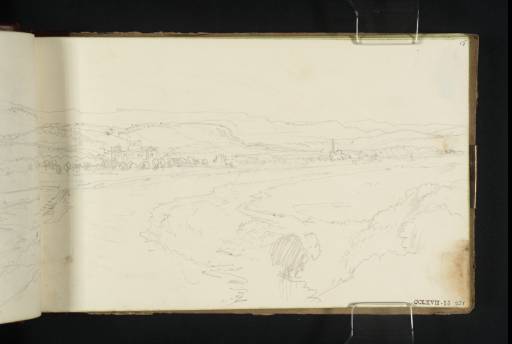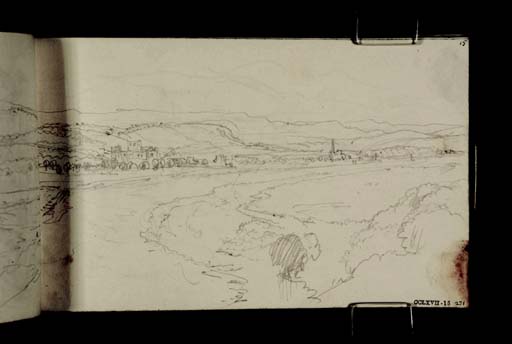J.M.W. Turner
>
1830-35 Annual tourist
>
Scotland 1831
>
Abbotsford Sketchbook
>
Artwork
Joseph Mallord William Turner Melrose 1831
Image 1 of 2
Joseph Mallord William Turner,
Melrose
1831
Joseph Mallord William Turner 1775–1851
Folio 15 Recto:
Melrose 1831
D25954
Turner Bequest CCLXVII 15
Turner Bequest CCLXVII 15
Pencil on off-white wove writing paper, 113 x 185 mm
Inscribed in blue ink by John Ruskin ‘15’ top right and ‘271’ bottom right
Inscribed in blue ink by John Ruskin ‘15’ top right and ‘271’ bottom right
Accepted by the nation as part of the Turner Bequest 1856
References
1909
A.J. Finberg, A Complete Inventory of the Drawings of the Turner Bequest, London 1909, vol.II, p.858, CCLXVII 15, as ‘Melrose Abbey, with Eildon hills, from the road. See Engraving, Scott’s Poems 1833.
1972
Gerald E. Finley, ‘J.M.W. Turner and Sir Walter Scott: Iconography of a Tour’, Journal of the Warburg and Courtauld Institutes, vol.35, 1972, pp.366 note 51, reproduced between pp.368–9 as pl.55d, 369, 383 note 142.
1980
Gerald Finley, Landscapes of Memory: Turner as Illustrator to Scott, London 1980, p.121, reproduced p.122 pl.50 as ‘Melrose Vale’.
2006
Christopher Baker, J.M.W. Turner: The Vaughan Bequest, Edinburgh 2006, p.111.
Across folios 14 verso and 15, and extending slightly onto folio 16 (D25953, D25954, D25956; CCLXVII 14a, 15, 16), is the sketch of Melrose from across the River Tweed that Turner used as the basis for his watercolour, Melrose 1831 (National Gallery of Scotland),1 engraved for part 6 of Sir Walter Scott’s Poetical Works. As Robert Cadell, who accompanied Turner when he made the sketch, reported: ‘The View just taken was on the Drygrange road – at a small road leading to a farm house.’2 Gerald Finley points out, ‘it seems that Turner climbed down through a field in order to find the viewpoint for the study from which the finished watercolour was derived.’3 The sketch was therefore made just below the road from Gledswood Farm, on the north bank of Tweed just east of its confluence with the Leader Water. This is close to Bemersyde Hill where a point on the road to Dryburgh is known as Scott’s View, after one of Sir Walter’s favourite beauty spots.
Turner’s sketch, which was translated closely into watercolour therefore looks west towards Melrose with the abbey at the centre left of the present page. In the foreground is the confluence of the Tweed and the Leader Water, and Melrose Parish Church is right of centre with Melrose suspension bridge to the right of that. Turner also sketched the bridge when he returned in 1834 in the Edinburgh sketchbook: Tate D26191 (Turner Bequest CCLXVIII 49a). The view is continued on folio 14 verso where it is dominated by two of the peaks of the Eildon Hills. Turner also slid back the present page so that he could continue the view at the right on folio 16.
Turner first visited Melrose in 1797, and on 6 August 1831 (two days before he made the present drawing) he had passed the same spot with Sir Walter Scott and admired the view, asking Scott whether he desired him to paint it or some other view for the Lay of the Last Minstrel. Scott is reported to have replied that the choice was Turner’s.4 The artist was evidently very taken with this view; though he also took several sketches of the abbey at close quarters as an alternative composition (see folio 12; D25948; CCLXVII 12).
Finley, who has studied the papers of Robert Cadell and Sir Walter Scott, has written about the selection of subjects for Scott’s Poetical Works. The original frontispiece illustration to the Lay of the Last Minstrel was to be Melrose by Moonlight. However, a few days after a discussion on 6 March two views of Melrose Abbey were suggested with a vignette of the abbey at close quarters and a frontispiece of a more distant view. Cadell seems to have pushed for there to be two views of Melrose following his visit with Turner.5 By 17 September, however, the final decision was made to use just the present view for the frontispiece.6
For references to other sketches of Melrose see folio 12.
Thomas Ardill
September 2009
Robert Cadell, ‘Abbotsford Diary’, Monday 8 August, National Library of Scotland, MS Acc. 5188, Box 1, folio 109; transcribed in Finley 1972, p.383.
Robert Cadell, ‘Abbotsford Diary’, Saturday 6 August, folio 106 verso; transcribed in Finley 1972, p.380.
How to cite
Thomas Ardill, ‘Melrose 1831 by Joseph Mallord William Turner’, catalogue entry, September 2009, in David Blayney Brown (ed.), J.M.W. Turner: Sketchbooks, Drawings and Watercolours, Tate Research Publication, December 2012, https://www


